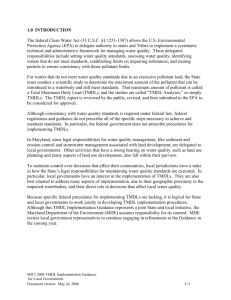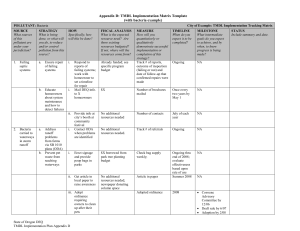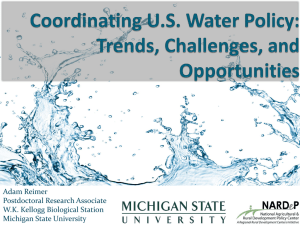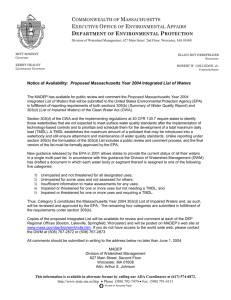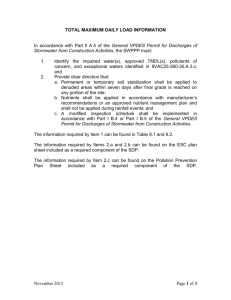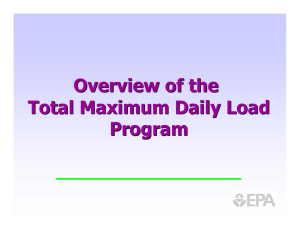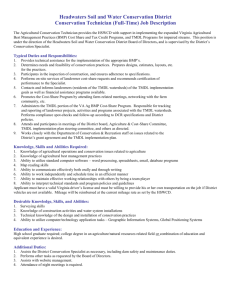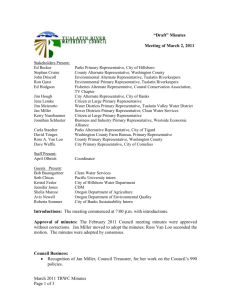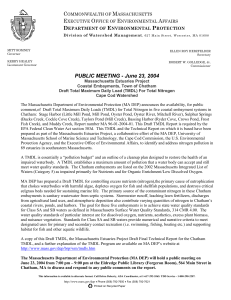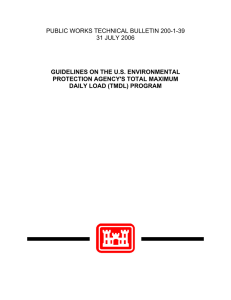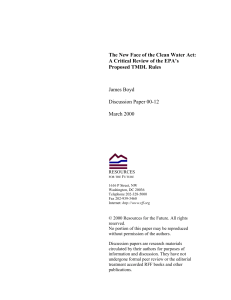Unleashing the Clean Water Act
advertisement
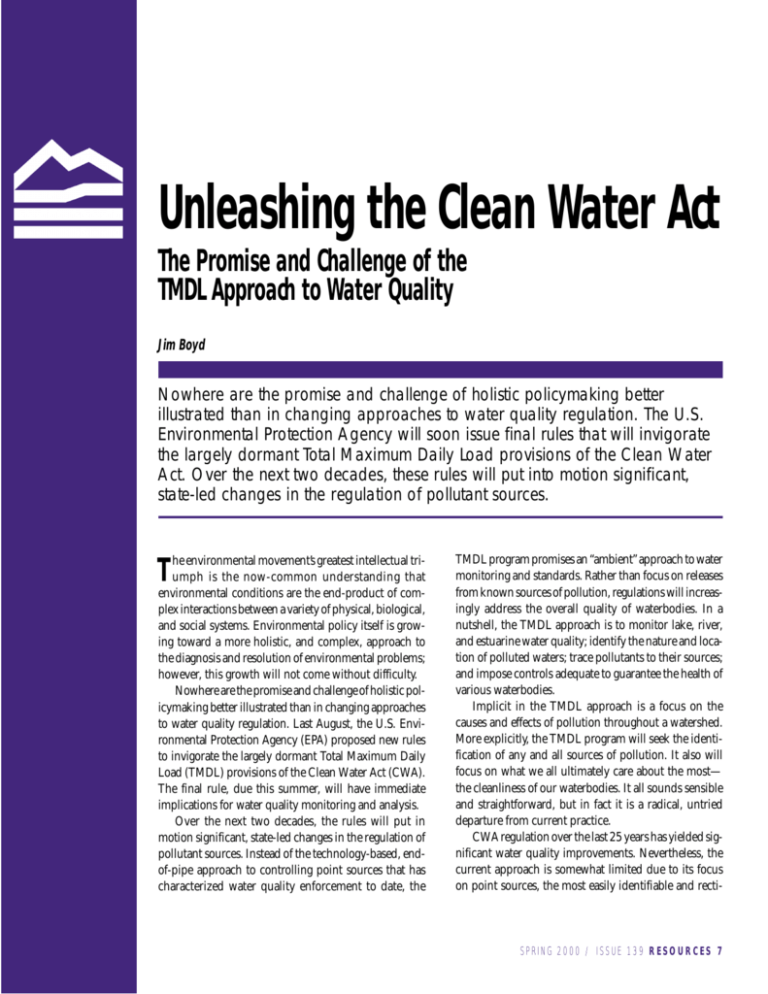
Unleashing the Clean Water Act The Promise and Challenge of the TMDL Approach to Water Quality Jim Boyd Nowhere are the promise and challenge of holistic policymaking better illustrated than in changing approaches to water quality regulation. The U.S. Environmental Protection Agency will soon issue final rules that will invigorate the largely dormant Total Maximum Daily Load provisions of the Clean Water Act. Over the next two decades, these rules will put into motion significant, state-led changes in the regulation of pollutant sources. T he environmental movement’s greatest intellectual triumph is the now-common understanding that environmental conditions are the end-product of complex interactions between a variety of physical, biological, and social systems. Environmental policy itself is growing toward a more holistic, and complex, approach to the diagnosis and resolution of environmental problems; however, this growth will not come without difficulty. Nowhere are the promise and challenge of holistic policymaking better illustrated than in changing approaches to water quality regulation. Last August, the U.S. Environmental Protection Agency (EPA) proposed new rules to invigorate the largely dormant Total Maximum Daily Load (TMDL) provisions of the Clean Water Act (CWA). The final rule, due this summer, will have immediate implications for water quality monitoring and analysis. Over the next two decades, the rules will put in motion significant, state-led changes in the regulation of pollutant sources. Instead of the technology-based, endof-pipe approach to controlling point sources that has characterized water quality enforcement to date, the TMDL program promises an “ambient” approach to water monitoring and standards. Rather than focus on releases from known sources of pollution, regulations will increasingly address the overall quality of waterbodies. In a nutshell, the TMDL approach is to monitor lake, river, and estuarine water quality; identify the nature and location of polluted waters; trace pollutants to their sources; and impose controls adequate to guarantee the health of various waterbodies. Implicit in the TMDL approach is a focus on the causes and effects of pollution throughout a watershed. More explicitly, the TMDL program will seek the identification of any and all sources of pollution. It also will focus on what we all ultimately care about the most— the cleanliness of our waterbodies. It all sounds sensible and straightforward, but in fact it is a radical, untried departure from current practice. CWA regulation over the last 25 years has yielded significant water quality improvements. Nevertheless, the current approach is somewhat limited due to its focus on point sources, the most easily identifiable and recti- SPRING 2000 / ISSUE 139 RESOURCES 7 JIM BOYD CHESAPEAKE BAY FOUNDATION The Nonpoint Source Challenge fiable pollution sources. Point sources are typically large factories or municipal sewage treatment plants. The fact that they were responsible for a significant fraction of water quality problems in the past and were easy to identify justified this narrow approach. But the low-hanging fruit of low-cost, high-volume point source controls has been harvested. Today, significant water quality improvement requires the expansion of controls to nonpoint sources. While industrial and municipal point sources will no doubt continue to be vivid symbols of the nation’s water pollution problems, this image is increasingly inappropriate. Water pollution from agricultural, commercial, and urban sources—called nonpoint pollution— while harder to caricature, should be the focus of our dissatisfaction. Hundreds of thousands of river miles and millions of lake acres remain impaired on account of it. Because nonpoint sources are a primary cause of those impairments, TMDLs will change the politics, economics, and implementation of water quality regulation. Along the way, water quality will increasingly be seen as interdependent with other spheres of concern, notably air quality and land use programs. Moreover, the tools required to understand the fate of pollutants, assign responsibility, and monitor compliance within watersheds will tax regulators’ technical and financial resources. Such is the price of holistic policymaking. 8 RESOURCES SPRING 2000 / ISSUE 139 Water quality improvements over the last 25 years have resulted primarily from point source controls. Future improvements must come principally from nonpoint source controls. Today, agricultural runoff, in the form of pesticides, fertilizer, and animal wastes, is the single largest contributor to the impairment of rivers and lakes. Logging and construction activities, many of them on federal lands, are a significant source of sediment contamination, as runoff carries fine-grained soils from roads and construction sites into lakes and streams. In urban and suburban areas, watershed degradation is closely tied to increased population density and residential and commercial development. In such areas, the relatively impermeable nature of the groundcover leads to rapid, unfiltered runoff to rivers, lakes and oceans from roadways and parking lots, chemically treated lawns, and commercial establishments. Increased attention is also being given to atmospheric deposition, where pollutants from airborne dust and industrial and commercial air emissions are absorbed by surface waters or precipitated via rainfall. One of the reasons why nonpoint sources are such a significant problem is that they present serious implementation, monitoring, and enforcement challenges. Nevertheless, the water quality problems they cause can no longer be ignored. In this context, it is not surprising that political and legal pressures are being applied to the EPA, and in turn to the states, to make something of the regulatory potential contained in the CWA’s TMDL provisions. The Changing Politics of Water Quality The seeds of this shift in regulatory emphasis have been in place since the CWA’s passage in 1972. The act contains provisions U N L E A S H I N G T H E C L E A N WAT E R A C T that call for enforcement to be driven by ambient water quality rather than end-of-pipe controls and for states to identify waters for which the point source controls elsewhere in the act “are not stringent enough to implement any water quality standard applicable to such waters.” States must prioritize any waters so identified, based on analysis of use and severity of degradation, and establish total maximum daily pollutant loads sufficient to bring the waters into compliance. During the first two decades of CWA enforcement, the states as well as the federal government largely ignored the TMDL provisions. But the failure of most states to attain water quality goals and the federal government’s desire to bring more sources into the regulated sphere has led to a reexamination of latent enforcement power in the CWA. The TMDL provisions are important because they require statewide assessments and public documentation of water quality problems, and they appear, at least in principle, to imply that states must allocate pollutant load reductions to sources not currently covered by load restrictions. Since the bulk of current impairment is caused by nonpoint sources, any state seeking further load reductions (at least on a cost-benefit basis) will be led directly to nonpoint sources. In this way, the shift to ambient monitoring and standards almost necessarily leads to a greater emphasis on nonpoint sources. EPA’s authority to implement the new TMDL rules is being challenged by a variety of agricultural interests on the grounds that authorizing legislation is required, given ambiguities in the CWA. The agency’s opponents argue that the CWA covers only waters impaired by point sources, thus leaving EPA without authority to promulgate such rules. The agency contends that the CWA provides it with ample authority to step in and issue nonpoint controls if there is evidence of ongoing impairments and inadequate state responses to them. These issues must be resolved in the coming years. The scope of federal authority will be challenged, as will state efforts to assign responsibility for load reductions under their own statutes. (In fact, the legal scrum is already well underway. A recent RFF report, “The New Face of the Clean Water Act: A Critical Review of the EPA’s Proposed TMDL Rules,” explores these issues in more detail.) But despite bumps in the road, movement toward a system of regulation that addresses nonpoint sources and that views water quality as a watershedwide issue is inevitable. Any enforcement of the CWA’s TMDL provisions will alter the politics of load reduction. The need to meet in situ water quality standards sets up a state-by-state confrontation between well-organized industrial interests (which can claim to have already paid their pollution control dues) and organized agricultural, commercial forestry, and municipal interests who resist the “expansion” of CWA-driven requirements to their hard-to-solve nonpoint problems. Absent nonpoint controls, point sources can reasonably expect to be held responsible for load reductions on TMDL-impaired waterbodies. This scenario is obviously of great concern to current point source permit holders. Technical Hurdles Posed by Watershed-Level Regulation A striking feature of this political and legislative history is that we have been down this road before. Statutory approaches that predate the CWA, such as the Water Quality Act of 1965, also called for ambient water quality standards and state-driven implementation plans (two fundamental features of the TMDL approach). The failure of these earlier approaches to water quality regulation is a cautionary tale. Water quality-driven standards and controls present a variety of daunting challenges. Looking to the future, these challenges loom large. The first step in the TMDL process is the listing of a waterbody as impaired. Impairment is established in reference to criteria set by the states; the criteria describe the standards, data to be used, and relevant guidelines necessary to ensure the quality of data analysis. These monitoring, classification, and notification requirements are the first administrative and technical challenge for states. While this is the least taxing of the exercises set in motion by the TMDL process, it is worth noting that many states have had difficulty in meeting even these preliminary requirements. With knowledge of impairments, states must put forward defensible plans for source reductions to bring the affected waterbody into attainment. This kind of exercise is fraught with technical difficulties. Analysis of loadings and the effect of load reductions requires some form of watershedwide modeling that captures transport processes (such as infiltration and runoff), groundwater and surface water interactions, pollutant accumulation and decay, and in-stream mixing. In the case of nonpoint source loads, the science is relatively undeveloped due to the complexity of the interacting systems involved. Knowledge of the relationship between control practices and loadings is particularly poor. Because of the wide range of pollutant sources, pathways, SPRING 2000 / ISSUE 139 RESOURCES 9 JIM BOYD and factors that affect loadings, source contributions will rarely if ever be known with certainty. Instead, the regulator must rely on models that attempt to capture the factors that affect the transport, deposition, and ultimate fate of pollutants in the waterbody. Models will also be required to predict how changes in land use brought on by economic growth will add to future loadings. The modeling techniques and data required for TMDL implementation will contribute significantly to the costs of implementation. Some simplicity and cost savings will undoubtedly be possible as states become more practiced in TMDL development (and as more resources are devoted to the development of data and models for use in this kind of program.) However, the degree to which data sources and modeling techniques can be standardized is limited. Each listed water segment is, in some sense, unique because of its hydrology, transport pathways, pollutant sources, and so forth. TMDL development will invariably involve site-specific analysis. A lack of scientific certainty will not by itself legally hobble TMDL plans, since certainty is not a prerequisite for program implementation. Uncertainty does place a premium, however, on administrative procedures that provide the greatest possible level of scientific credibility to standards, models, and data collection. Pollutant sources, unhappy with their designation, will undoubtedly seek relief from TMDL controls by challenging a state’s modeling tools, water quality criteria, and data collection procedures. Accordingly, the technical details of state TMDL programs should be subject to ongoing notice and comment procedures and evaluation by expert panels. This is likely to be a source of both significant up-front and long-run program costs. Credibility, transparency, and enforceability are particularly paramount if flexible environmental controls, such as effluent trading, are to be realistically contemplated. on air quality regulation. Air deposition is a major source of water pollution; a prime example is nitrogen oxides deposition to the Chesapeake Bay. Air deposition links water quality in one state with air emissions in another. While the implications of this linkage have not been fully contemplated, it does create the distinct possibility of jurisdictional conflict both across state borders and within EPA program offices. (See Resources 137, “A Dilemma Downwind” for more on the inter-jurisdictional implications of clean air policy.) In addition, the TMDL rules will increasingly highlight the artificial distinction between water quality and quantity issues, particularly in the West. Water quantity decisions, which are controlled primarily by state law, often have a direct impact on water quality: changes in stream flow affect the transport of pollutants; the amount of water taken or returned to a waterbody may significantly affect the dilution of pollutants; and water supply often determines the suitability of a waterbody as habitat for fish or other species. Because of these interactions, water quantity decisions (relating to irrigation, damming, reservoir management, basin-to-basin trades, and the like) may affect a water’s TMDL status. Accordingly, TMDLs will in some cases constrain water transfers involving impaired waterbodies. Despite the challenges it presents, the TMDL approach clearly demonstrates movement toward a welcome, mature phase of water quality regulation. The key feature of EPA’s proposed TMDL rules is that they are motivated by, and address, water quality issues created by the widest range of sources. The holistic, watershed-level analysis required by the TMDL process will inevitably identify a larger sphere of often-unregulated discharge sources. For these reasons alone, the TMDL program is likely to promote significant, desirable changes in the implementation of water quality regulation. The Scope of Interactions The TMDL program’s ambitions are all the more notable when their interactions with other areas of environmental law and regulation are considered. Consider the potential impact of TMDLs 10 RESOURCES SPRING 2000 / ISSUE 139 Jim Boyd is a fellow in RFF’s Energy and Natural Resources Division.
